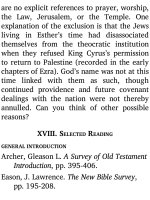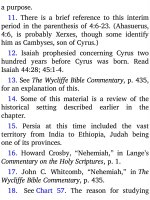Jensens survey of the old testament adam 468
Bạn đang xem bản rút gọn của tài liệu. Xem và tải ngay bản đầy đủ của tài liệu tại đây (117.36 KB, 4 trang )
2. Argument: Saints shall be raised, 12-19
3. Declaration: Christ was raised, giving
hope for the believer’s future, 20-28
4. Argument: Christ was raised, giving
meaning to the believer’s present, 29-34
Question: “With what body are the dead
raised?” (15:35)
Answer: The Nature of the Resurrection
Body (15:35-57)
1. Supernatural body, 35-38
2. Heavenly image, 39-49
3. Incorruptible character, 50-57
Conclusion: “Be steadfast” (15:58)
VI. SUMMARY AND THEME OF 1 CORINTHIANS
In 1 Corinthians Paul makes an honest
diagnosis of the young church of Corinth,
and he shows solutions for its problems and
shares testimony so that the young
congregation that he founded can be
restored to its former spiritual health.
The problems of the congregation as a
group include
disunity, sophisticated
intellectualism, neglect of discipline of its
members, evil fellowships, and civil
lawsuits. Those are the problems “reported”
to Paul by concerned believers in the church
(1:10—6:20).
Then there are personal problems of the
individual members, problems about which
the church wrote Paul for his counsel (7:1—
15:58). Those involve the responsibilities of
marriage, the question of whether to marry
or not to marry, and whether to eat meat
that had been sacri ced to idols. Paul also
answers questions about the worship service,
speci cally about the place of man and
woman in the service, abuses of the Lord’s
table, and an evaluation of spiritual gifts in
the ministry of the gospel.
Paul devotes the last chapter of the main
body of the epistle to the cardinal doctrine
of the Christian faith: the resurrection. Every
church has its problems, but what about
man’s most desperate plight — the
appointment with death? Resurrection “in
Christ” (15:22) is Paul’s answer, and it is
that truth that brings the apostle to the peak
of the epistle, in the praise, “thanks be to
God, who gives us the victory through our
Lord Jesus Christ” (15:57), coupled with the
appeal to be “steadfast, immovable, always
abounding in the work of the Lord” (15:58).
How would you identify the theme of 1
Corinthians, in one sentence? From that
theme derive a title.
VII. KEY WORDS AND VERSES OF 1 CORINTHIANS
What key words and verses did you
observe in the course of your survey?
Compare those with the ones listed on Chart
70. Related to the key word cross, there are
fourteen direct references to Calvary in the
letter, in words such as “cruci ed,” “died.”
Hence the book has been called “the epistle
of the doctrine of the Cross in application.”
VIII. APPLICATIONS FROM 1 CORINTHIANS
1. Two main values of studying 1
Corinthians are: seeing God’s diagnosis of
our own spiritual maladies; and learning His
prescriptions for cure. Write a list of some of
the maladies and prescriptions that you
consider to be crucial in the life of a local
church today.
2. Try writing out your own re ections on
the superlative quality of love, as measured
by 1 Corinthians 13. Include the excelling









